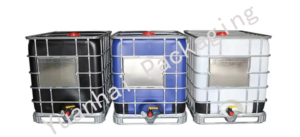What is a composite IBC (Intermediate Bulk Container)?
What is this IBC dump for?
Need test?
What are the tests?
Composite Intermediate Bulk Containers (IBCs), consisting of a steel structural outer frame and rigid plastic inner packaging and their auxiliary devices, whose construction is characterized by the fact that the outer frame and the inner packaging form a single integral unit and are used as a single unit during storage and transportation.
IBC drums have matured and are widely used in the chemical, pharmaceutical, grease, paint, and food industries. IBC drums, with their safety and environmental protection, easy mechanical loading and unloading, saving storage and transportation space, and convenient filling and draining, have the incomparable advantages of other packaging products regarding space cost saving, efficiency improvement, and convenience of movement. Today, Sister Minnie will introduce the testing items of IBC barrels to you.
Appearance
Whether the plastic inner container has sand holes, poor plasticization, the outer wall is not polished, the mouth is not flat, and other issues, as well as the number of bubbles and the size of the standard provisions.
Size
Check that the container dimensions meet the requirements, including the length, width, and height.

Capacity
The capacity of the container should be by national standards or relevant regulations to avoid problems caused by insufficient or excessive capacity.

Bottom Lift Test
Through the bottom lifting test, it is possible to determine the maximum bearing weight and height of IBC drums under bottom lifting and handling conditions and to make improvements based on these data, which can improve the container’s load-bearing capacity, reduce wear and tear, improve stability, and facilitate stacking, thus improving the service life of the containers and the efficiency of transportation.

Stacking Test
The stacking test simulates the pressures and weights to which IBC drums are subjected in a stacking situation to assess their structural strength and stability. It also determines the maximum weights and heights to which IBC drums are subjected and establishes whether the IBC drums can withstand these pressures without rupture or deformation.

Air Tightness Test
The hermeticity test determines the sealing performance of an IBC drum to ensure that it will maintain the integrity and quality of the item during transportation and use. In addition, occult testing can help manufacturers identify any possible defects or problems and take the necessary steps to resolve them.

Drop Test
The drop test simulates the drops and falls that IBC drums are subjected to during transportation. It evaluates their structural strength and durability and checks that the IBC drums can withstand these drops without rupturing and leaking. The samples and contents must be in an environmental chamber (-18°) before the drop test.

Hydraulic Test
During transportation and use, they may be subjected to liquid or gas pressure, so it is essential to conduct a hydraulic test. This test simulates the pressure environment to which IBC drums are subjected during transportation. It evaluates their structural strength and stability and checks that IBC drums can withstand these pressures without rupturing or leaking.

Vibration Test
Vibration testing simulates the vibration environment to which IBC drums are subjected during transportation and is used to assess their structural strength and stability. IBC drums are examined to see if they can withstand these vibrations without rupture, leakage, or deformation, and structural components must be free from breakage or failure, such as open welds or fastener failure.

Hygienic Performance
IBC drums should comply with relevant national laws, regulations, and health standards when used to contain food packaging.





